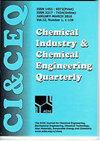稻谷柜式托盘干燥动力学的人工神经网络建模
IF 0.8
4区 工程技术
Q4 CHEMISTRY, APPLIED
Chemical Industry & Chemical Engineering Quarterly
Pub Date : 2022-01-01
DOI:10.2298/ciceq220106017s
引用次数: 1
摘要
研究农产品的干燥动力学和干燥特性对干燥时间的估计、干燥机的设计和干燥工艺的优化具有重要意义。不同干燥条件下的水分扩散率对工艺和设备设计至关重要。采用人工神经网络(ANN)技术对稻谷柜式托盘干燥机的干燥动力学进行了建模。对于水分比和干燥速率的预测,采用TANSIGMOID和TANSIGMOID隐层激活函数的Levenberg-Marquardt (L.M.)训练算法具有较好的预测效果。对比评价了人工神经网络与12种不同干燥数学模型的预测能力。发现Midilli模型足以拟合实验数据,其R2与人工神经网络相当。然而,ANN模型的RMSE(0.0360)显著低于midilli模型的RMSE(0.1673 ~ 0.712)。有效水分扩散率随着温度的升高而增加,从15.05增加到28.5 × 10-9 m2/s。稻谷干燥活化能在6.8 ~ 7.3 kJ/mol之间,水分扩散所需能量适中。本文章由计算机程序翻译,如有差异,请以英文原文为准。
Artificial neural network modeling for drying kinetics of paddy using a cabinet tray dryer
The study of drying kinetics and characteristics of agricultural products is essential for drying time estimation, designing dryers, and optimizing the drying process. Moisture diffusivity under different drying conditions is crucial to process and equipment design. The drying kinetics of paddy using a cabinet tray dryer was modeled using an Artificial Neural Network (ANN) technique. For predicting moisture ratio and drying rate, the Levenberg-Marquardt (L.M.) training algorithm with TANSIGMOID and TANSIGMOID hidden layer activation function provided superior results. A comparative evaluation of the predicting abilities of ANN and 12 different mathematical drying models was also carried out. The Midilli model was found to be adequate for fitting the experimental data with an R2 comparable to that of the ANN. However, the RMSE observed for ANN (0.0360) was significantly lower than that of the midilli model (0.1673 to 0.712). Effective moisture diffusivity increased with an increase in temperature from 15.05 to 28.5 x 10-9 m2/s. The activation energy for drying paddy grains varied between 6.8 to 7.3 kJ/mol, which showed a moderate energy requirement for moisture diffusion.
求助全文
通过发布文献求助,成功后即可免费获取论文全文。
去求助
来源期刊

Chemical Industry & Chemical Engineering Quarterly
CHEMISTRY, APPLIED-ENGINEERING, CHEMICAL
CiteScore
2.10
自引率
0.00%
发文量
24
审稿时长
3.3 months
期刊介绍:
The Journal invites contributions to the following two main areas:
• Applied Chemistry dealing with the application of basic chemical sciences to industry
• Chemical Engineering dealing with the chemical and biochemical conversion of raw materials into different products as well as the design and operation of plants and equipment.
The Journal welcomes contributions focused on:
Chemical and Biochemical Engineering [...]
Process Systems Engineering[...]
Environmental Chemical and Process Engineering[...]
Materials Synthesis and Processing[...]
Food and Bioproducts Processing[...]
Process Technology[...]
 求助内容:
求助内容: 应助结果提醒方式:
应助结果提醒方式:


